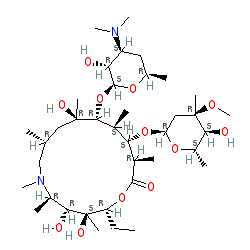GtoPdb is requesting financial support from commercial users. Please see our sustainability page for more information.
|
azithromycin is an approved drug (FDA & UK (1991))
Compound class:
Synthetic organic
Comment: Azithromycin is a macrolide antibacterial with broad-spectrum activity against Gram-positive and atypical bacteria. The compound also has antimalarial activity.
Azithromycin is one of the watch group antibacterials in the the World Health Organization's Model List of Essential Medicines (link provided in the Classification table below). The Malaria tab on this ligand page provides additional curator comments of relevance to the Guide to MALARIA PHARMACOLOGY. Ligand Activity Visualisation ChartsThese are box plot that provide a unique visualisation, summarising all the activity data for a ligand taken from ChEMBL and GtoPdb across multiple targets and species. Click on a plot to see the median, interquartile range, low and high data points. A value of zero indicates that no data are available. A separate chart is created for each target, and where possible the algorithm tries to merge ChEMBL and GtoPdb targets by matching them on name and UniProt accession, for each available species. However, please note that inconsistency in naming of targets may lead to data for the same target being reported across multiple charts. ✖ |
|
|||||||||||||||||||||||||||||||||||
| Immunopharmacology Comments |
| Azithromycin alleviates the severity of rheumatoid arthritis by antagonising the unfolded protein response component of heat shock protein family A (Hsp70) member 5 (HSPA5; a.k.a. glucose-regulated protein 78/GRP78) [5]. Direct binding of azithromycin to HSPA5 was suggested by a drug affinity responsive target stability (DARTS) screening assay, and was confirmed by cellular thermal shift assay. Azithromycin competes with ATP for binding to the ATPase active site of HSPA5. |










